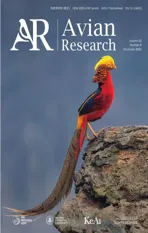Demographic and behavioral responses of the White-winged Dove to human disturbances during winter in northwestern Mexico
2023-01-03RuenOrtegaAlvarezJovaniLeonAguilarAntonioIsainContrerasRorguezGustavoCastanealosSantos
Ru′en Ortega-′Alvarez,Jovani Le′on-Aguilar,Antonio Isain Contreras-Roríguez,Gustavo Casta~nea e los Santos
a Instituto de Investigaciones en Ecosistemas y Sustentabilidad(IIES)-Universidad Nacional Aut′onoma de M′exico,Campus Morelia,Antigua Carretera a P′atzcuaro 8711,Col.San Jos′e de la Huerta,Morelia,Michoac′an,58190,Mexico
b Programa de Aves Urbanas(PAU),Los Mochis,Sinaloa,Mexico
c Quirino Mendoza #320,Colonia del Carmen,Xochimilco,Ciudad de M′exico,16720,Mexico
d Departamento de Educaci′on Ambiental,Jardín Bot′anico Benjamin Francis Johnston,Sinaloa,Mexico
Keywords:Agriculture Density Perch Sinaloa Urbanization Zenaida asiatica
ABSTRACT The simultaneous study of demography and behavior might provide a more comprehensive understanding about animal responses to anthropogenic disturbances.The White-winged Dove(Zenaida asiatica)is a frequent dweller of urban and agricultural habitats in North America,Central America,and the Caribbean.Still,research on the species is heavily biased to the USA.We analyzed the response of the species to human disturbances during winter across an urban-agricultural landscape in northwestern Mexico through a demographic and behavioral approach.We modeled the effect of disturbance types(pedestrians,cars,pavement and building cover)on the density of the species.Also,we investigated if surveillance behavior varied across the landscape by estimating and comparing perching proportion among land uses(urban grey areas,urban green areas,cropfields,shrublands).We did not detect the species within cropfields,possibly because food resources were not available for the dove during winter in this land use.Pavement cover limited species’density,as it might reduce the surface of the preferred feeding substrates of the dove.Pedestrians and building cover increased the density of the species,as they might provide food and shelter for the dove,respectively.Surveillance behavior peaked in urban grey areas,whereas it dropped in urban green areas.Differences on threat levels,threat type,and protective cover among land uses might influence such behavioral pattern.Our approach contributes to the knowledge of the species and demonstrates that both demographic and behavioral cues provide complementary evidence for analyzing the impact of human disturbances on animals.
1.Introduction
Anthropogenic disturbances associated with human population size,car traffic,and impervious surface cover limit the presence and survival of animals in human-dominated landscapes.For instance,mass of people decreases the availability of resources and deters habitat use by fauna(Jokim¨aki et al.,2011;Corradini et al.,2021);road kills reduce and isolate animal populations(Spellerberg,1998;Erritzoe et al.,2003);and the increment of impervious surface cover decreases habitat suitability,fitness,and body condition of wild animals(Dowling et al.,2012;McCluney et al.,2017).Bird communities have received special attention to comprehend the impact of human disturbances on fauna in urban and agricultural contexts(Chace and Walsh,2006;Sekercioglu,2012).Still,some observed patterns for communities might be masked by particular bird groups and species(Ortega-′Alvarez et al.,2013;Supp and Ernest,2014),resulting in contradictory patterns.By way of illustration,migratory insectivorous birds might be able to use urban-cropfield areas,whereas resident insectivorous birds might not(Ortega-′Alvarez et al.,2021).As a result,ecological assessments of communities dominated by migratory insectivore species might suggest a positive response of birds to urbanization and agriculture,whereas evaluations focused on communities over-represented by resident insectivorous birds might suggest the opposite pattern.Thus,it is important to perform species-specific studies to facilitate a detailed comprehension of animal responses to human disturbances(Jokim¨aki et al.,2011).
Increasing the evaluation of demographic and behavioral responses of birds to human disturbances might provide a more comprehensive understanding about the effects of human-dominated landscapes on animals,in order to mitigate their threats(Chace and Walsh,2006;Jokim¨aki et al.,2011;Ortega-′Alvarez and MacGregor-Fors,2011).For example,density research is fundamental for determining population trends and guiding conservation initiatives(Wolfaardt and Phillips,2011;Marques et al.,2013).However,previous density studies have neglected biases associated with the imperfect detectability of species in the field(MacKenzie et al.,2002;Archaux et al.,2012),limiting the application of their results(MacKenzie,2005).Moreover,the inclusion of covariates during density modelling has been overseen,even when hierarchical models that allow for the inclusion of covariates are currently available(Marques et al.,2007;K′ery and Royle,2015;Chandler,2020).Additionally, behavioral assessments are underrepresented in urban-agricultural studies(Jokim¨aki et al.,2011),mainly throughout the Neotropical region(Ortega-′Alvarez and MacGregor-Fors,2011).The analysis of behavior is key for providing other information that complements the evidence gathered by population and community studies(Ortega-′Alvarez et al.,2021).Hence,promoting the simultaneous examination of both demography and behavior should be fostered to perform an integral evaluation of bird responses to disturbances.
Surveillance behaviors might enhance bird survival in anthropogenic landscapes where human disturbances are frequent and severe(Fern′andez-Juricic and Tellería,2000;Lowry et al.,2013).Particularly,birds surveil surroundings when perching,which represents a vital behavior for detecting threats,relating with conspecifics,and finding resources(Swanson and Rappole,1993;Krams,2001;Portugal et al.,2017).Given that perching events might be effectively surveyed in the field(Krams,2001;Campos et al.,2009),their use as a metric for assessing surveillance activities across human-dominated landscapes and exploring bird responses to anthropogenic disturbances might prove helpful.
The White-winged Dove(Zenaida asiatica)is a frequent dweller of urban and agricultural landscapes from southern United States of America south through Central America and the Caribbean(Howell and Webb,1995).In fact,agriculture and urbanization have fostered its northward range expansion(Small et al.,2006;Brennan et al.,2017;Schwertner et al.,2020).During the breeding season,it inhabits riparian forests,deserts,shrublands,mixed woodlands,urban settlements,and grain fields(Cottam and Trefethen,1968;West,1993;Cunningham et al.,1997).Still,there is a huge lack of knowledge about its population and behavioral ecology south to the USA border,specially during winter(Schwertner et al.,2020).More research throughout its range is essential to fully comprehend the ecology of the species and assess the impacts of human disturbances on its populations(Marra et al.,2015;Fink et al.,2020).
We analyzed the response of the White-winged Dove to anthropogenic disturbances during winter across a landscape heavily impacted by both urbanization and agriculture(i.e.,crop production)in northwestern Mexico.In particular,we used the White-winged Dove as a model species given that it responds to habitat changes induced by urbanization and agriculture(Schwertner et al.,2020),and its conspicuousness favors the simultaneous evaluation of its demography and behavior.White-winged Dove responses to human disturbances were assessed by comparing two different ecological parameters:population density and surveillance behavior.Firstly,we determined the effect of four disturbance types(i.e.,pedestrians,cars,pavement cover,building cover)on the density of the species by using hierarchical modelling techniques that consider the effect of covariates and the imperfect detectability of the species in the field(Mackenzie et al.,2002;Chandler,2020).Secondly,we investigated if surveillance behavior of the species varied across the landscape by estimating and comparing the proportion of perching events among land uses(i.e.,urban grey areas,urban green areas,cropfields,shrublands).Our approach contributes to the ecological knowledge of the species in a sub-studied region during winter,and demonstrates that considering both demographic and behavioral cues provide complementary evidence for analyzing the impact of human disturbances on animals.
2.Methods
2.1.Study landscape
We performed this study at Los Mochis,Sinaloa,northwestern Mexico(25°47′24.33′′N,108°59′50.50′′W,10 m a.s.l.).The landscape has been severely modified by urbanization and cropfields,but some isolated patches of natural ecosystems(e.g.,shrublands)are still present in the area.The sprawling city of Los Mochis covers an area of~5838 ha and harbors 256,613 inhabitants(IMPLAN,2020),representing the third most important city of Sinaloa.Agriculture is a key activity in the region,with more than 284,434 ha set aside for cropfields(SIVASA,2017).Since 1970,crop production has dramatically increased,resulting in the severe modification,damage,and destruction of natural ecosystems(de Ita Rubio,2003;Norzagaray Campos et al.,2010;García-Guti′errez and Rodríguez-Meza,2012).Main crops include corn(Zea mays),sorghum(Sorghum bicolor),and beans(Phaseolus vulgaris),which are produced with semi-industrialized techniques.Shrublands are still present in the area,but they are very fragmented and isolated.
For studying the demographic and behavioral responses of the Whitewinged Dove to human disturbances across the landscape,we surveyed the main land uses present in the site,comprising:urban grey areas,which include streets,sidewalks,and squares located in residential and commercial zones of the city;urban green areas,which are represented by median strips,small parks,sports fields(i.e.,golf,baseball),and a botanical garden(i.e.,Jardín Bot′anico Benjamin Francis Johnston);shrublands,which are dispersed in the outskirts of the city and are dominated by plant species such as Huisache(Vachellia farnesiana),Mesquite(Prosopis spp.),Mexican Palo Verde(Parkinsonia aculeata),Mimosa(Mimosa spp.),and Organ Pipe Cactus(Stenocereus thurberi ssp.thurberi);and cropfields,where corn,potato(Solanum tuberosum),tomato(Solanum lycopersicum),and beans are produced.
2.2.Dove surveys
The White-winged Dove has both resident and winter migratory populations in the study landscape(Howell and Webb,1995;Schwertner et al.,2020).However,no previous ecological studies about the species have been performed across the region.According to research from the USA,the dove has experienced an increment on its abundance and distribution that is mainly associated with anthropogenic activities,such as agriculture.Urban areas have also been important for the proliferation of this species,as it nests on shade and ornamental trees located within human settlements(Small et al.,1989;George,1991).Herb seeds and fruits are the primarily food items consumed by the White-winged Dove,which are visually located by racking litter with the bill(Dolton,1975;Cunningham et al.,1997).Feeding preferences vary seasonally and might be determined by resource availability.Corn,wheat,and sunflower are usually ingested by the species within farms,whereas it forages on fruits and seeds crushed by vehicles in urban areas(Schwertner et al.,2020).The White-winged Dove may be solitary or highly gregarious,exhibiting territorial behaviors during the breeding season.Predators in shrublands include Short-tailed Hawk(Buteo brachyurus),Grey Hawk(Buteo plagiatus),Red-tailed Hawk(Buteo jamaicensis),and Bobcat(Lynx rufus).Urban predators comprise House Cats(Felis domesticus),Virginia Opossum(Didelphis virginianus),Raccoon(Procyon lotor),and Ringtail(Bassariscus astutus).Collisions with cars and windows might represent a threat for the species in cities(Schwertner et al.,2020).
We surveyed White-winged Doves by using 10-min point count stations(Bibby et al.,2000).We used a 30-m radius for point count stations to be certain of the land use that doves were actually using,and for relating disturbance types of stations with the records of the species(see“Disturbance characterization”subsection).We examined a total of 120 point count stations,which were distributed among the main land uses found across the study landscape:urban grey areas(30 points),urban green areas(30 points),cropfields(30 points),and shrublands(30 points)(Fig.1).Each point count station was visited once.Stations were separated by a minimum distance of 200 m to ensure independence in bird counts(Bibby et al.,2000).Surveys were performed during the boreal winter(February)of 2021.This short survey period that endured less than a month allowed us to reduce the probability of including in our counts individuals on transit.We started surveying birds from sunrise and stopped after 4 h of work to cover bird peak activity in the site.We determined dove distances from the center of the stations by using 5 m bands.The limit of the bands were marked with small flags for increasing the precision of measured distances.Distances were registered for both seen and heard doves and were used to estimate the density of the species(see“Density estimation”subsection).Additionally,we recorded the behavior of those individuals that were visually detected to compare surveillance activities of the White-winged Dove among land uses(see“Surveillance assessment”subsection).The type of behavior was defined during the first 5 s after detection,in order to avoid autocorrelation and diminish the effect of the observer on the individual(Wagner,1981;Acevedo,2007).Behaviors were classified as“perching”,when the individual sat on any substrate and performed no other apparent action;and“other”,when the individual performed any different activity to that of perching.
2.3.Disturbance characterization
We measured four disturbance types at each of the fixed-radius(30 m)point count stations that we used for surveying doves.Disturbance types comprised:“pedestrians”,which represented the number of people who passed within the station during a 3-min period;“cars”,measured as the number of motor vehicles present within the station during a 3-min period;“pavement cover”,visually determined as the percentage of the station that was covered with asphalt;and“building cover”,which was visually calculated as the percentage of the station that contained houses,enclosing walls,and buildings.All disturbances were measured within point count stations by a unique observer after surveying doves.Differences on disturbances among land uses were assessed with an analysis of variance for each of the four disturbance types.
2.4.Density estimation
We used the R package“unmarked”(Fiske and Chandler,2011)to implement a distance sampling approach for estimating the density of the White-winged Dove.In particular,we used hierarchical models that account for the imperfect detectability of the species in the field and allow the inclusion of covariates for performing density estimations(Royle et al.,2004;Chandler,2020).Given that our data set presented over-dispersion,we employed negative-binomial distribution models(Chandler,2020).Dove detection distances within point count stations where organized in 5 m discrete intervals to perform the analyses.Although we used both half-normal and hazard-rate detection functions to model the detectability of the species(Marques and Buckland,2003),we excluded those models based on the hazard-rate detection function given that they did not converge.We constructed our candidate models set by modelling density as a function of pedestrians,cars,pavement cover,and building cover to determine if these disturbance types affected the aforementioned population parameter.We considered all the possible combinations among disturbance types to construct additive models and evaluate their effect on density estimation.Still,we used an upper limit of three terms in a single model and excluded the interaction of covariates from the candidate models set to avoid overparameterization and enhance the interpretation of results.Also,we included a model in which density was not affected by any disturbance type(intercept-only model)within our candidate models set for verifying if such a model could have more support than those that considered the effect of disturbances on density.We did not include covariates for modelling the availability of detection nor the probability of detection because this would have reduced the data that we needed to estimate density;moreover,they were not the parameters of interest for our research.Thus,only an intercept term and no covariates were used to model these two specific parameters.As a result,our candidate models set comprised 15 models(Table 1).
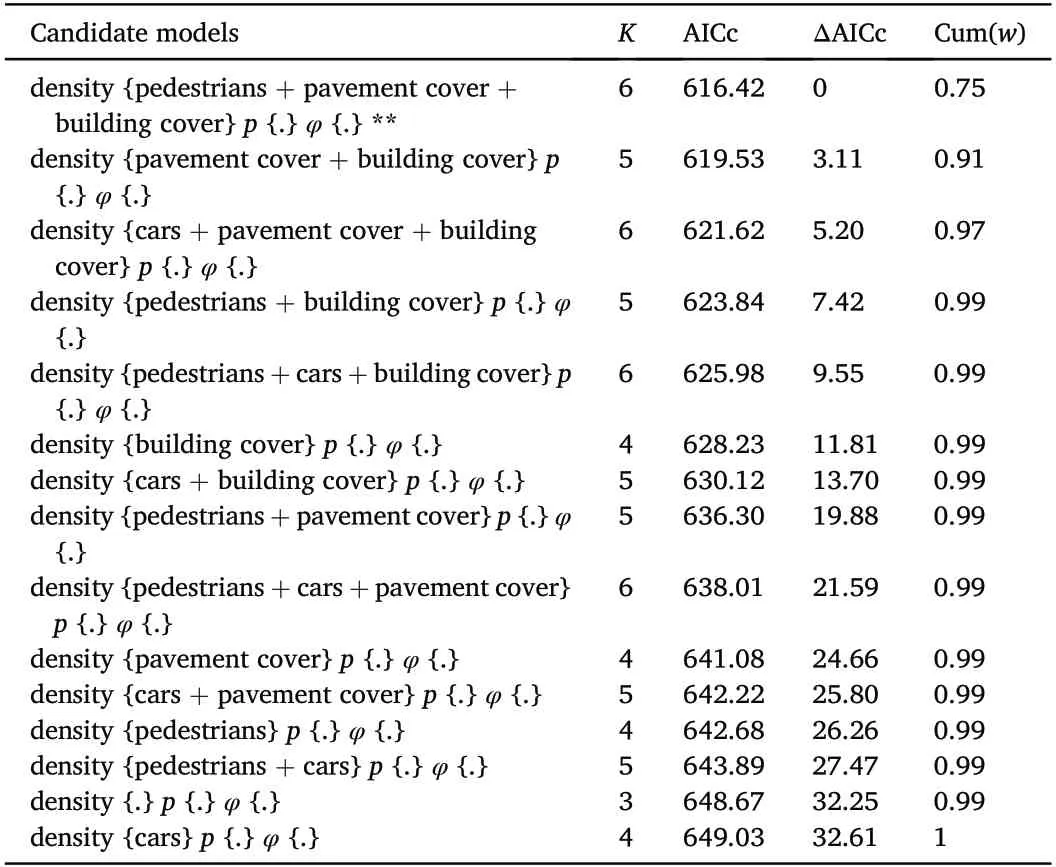
Table 1 Candidate models set used for determining the effect of disturbance types on the density of the White-winged Dove during winter.Density was a function of pedestrians,cars,pavement cover,and building cover.Only an intercept term and no covariates were used to model detection probability(p)and availability for detection(φ).K:number of parameters in the model;AICc:Akaike's Information Criterion corrected for small sample size;ΔAICc:difference in Akaike's Information Criterion with respect to the best fit model;Cum(w):cumulative AICc weight;**:best-supported model.
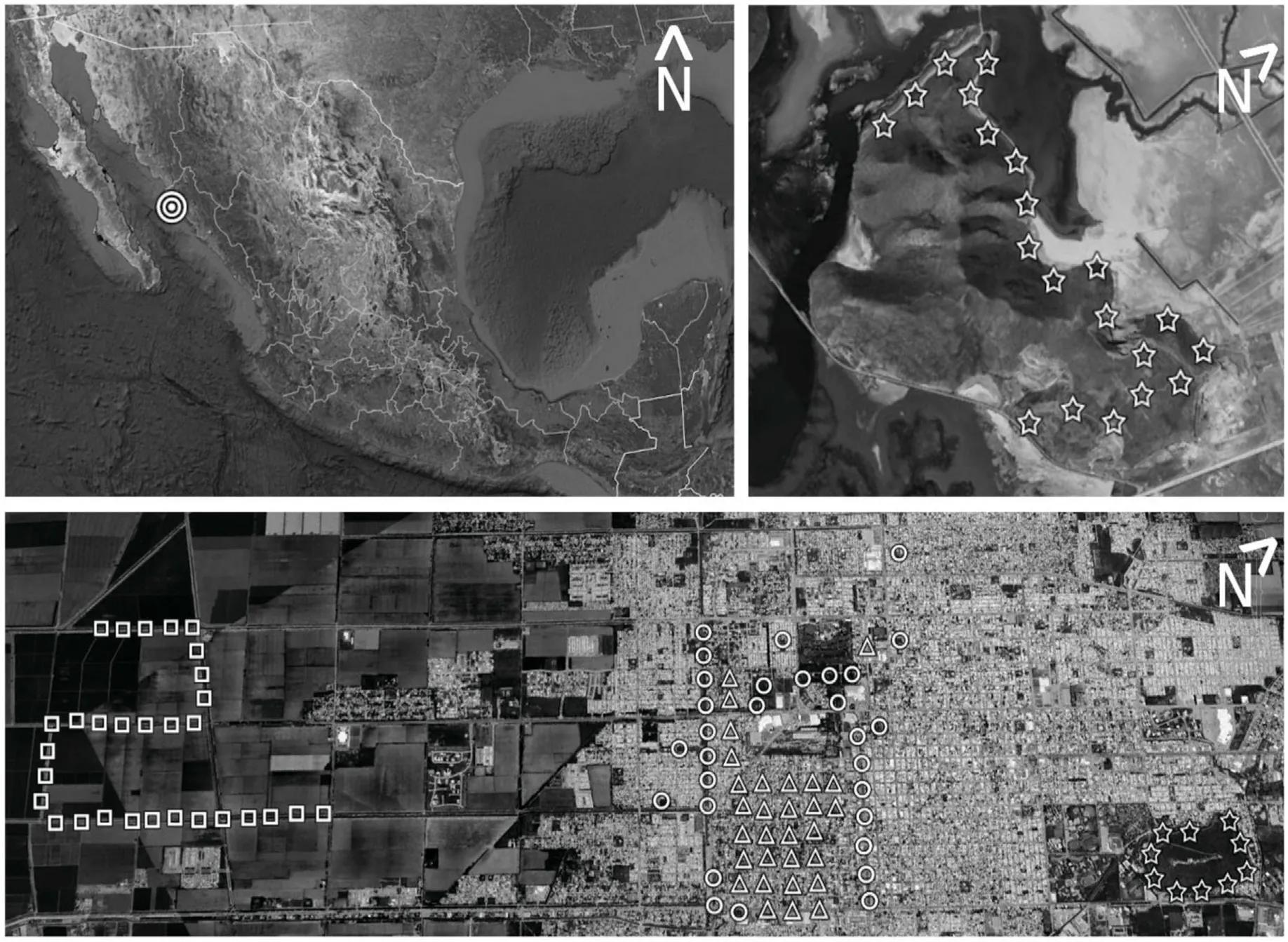
Fig.1.Map of the study site.Top left:location of Los Mochis,Sinaloa,at northwestern Mexico.Top right:shrublands at the outskirts of Los Mochis,located about 10 km southwest from the site where we surveyed cropfields.Bottom:Los Mochis urban area and its adjacent cropfields.We surveyed the White-winged Dove in 120 point count stations(30 per land use)located within urban green areas(circles),urban grey areas(triangles),cropfields(squares),and shrublands(stars).
We used the Akaike's Information Criterion corrected for small sample size(AICc)to perform model selection.Best supported models were identified as those that exhibited a difference<2 AICc units in relation to the best-fitting model.We considered that disturbance types affected density when the 95% confidence intervals of their regression coefficients did not include zero.Finally,we used regression coefficients to generate predictive curves for those disturbance types that affected the density of the White-winged Dove.
2.5.Surveillance assessment
Perching might provide the opportunity to birds for patrolling their surroundings and locate threats(Swanson and Rappole,1993;Krams,2001;Portugal et al.,2017).For example,doves might perch under predation risk,as a fear response,or for watching over predators(Lendrem,1984;Rivera-Mil′an et al.,2015).As a result,perching behavior might be useful for assessing bird surveillance(Krams,2001;Campos et al.,2009).We used perching records as proxies for surveillance behavior of the White-winged Dove and analyzed their variation across the study landscape.Given that doves might carry out other actions that surveillance when perching,we only considered for our analyses perching records that were not simultaneously performed with other behaviors,such as sleeping,feeding,preening,or courting.We employed the R package“BayesianFirstAid”(Baath,2014),implemented with JAGS(Plummer,2003),to perform a test of proportions and compare surveillance behavior among land uses.As distinguished fromthe total number of observed behaviors for the same land use,we modeled the proportion(θ)of times that we recorded the White-winged Dove perching in urban grey areas,urban green areas,cropfields,and shrublands utilizing a hierarchical binomial model(Kruschke,2015).We modeled θ initially using an uninformative beta prior with α=β=1.Estimated proportions were compared among land uses for estimating the difference in perching probabilities that occurred within each land use.We considered that perching probability was significantly different between two land uses if 95% highest density intervals of the posterior distribution of the estimated difference did not include zero.Markov Chain Monte Carlo using three Markov chains and 5000 iterations was used to perform Bayesian inference.We used the R-hat statistic to assess convergence(Gelman and Rubin,1992).
Their brother who is taller than they are, stands in the swing; he has one arm round the rope, to steady himself; in one hand he holds a little bowl, and in the other a clay pipe; he is blowing bubbles
3.Results
We compiled a total of 174 records of the White-winged Dove across the study landscape.Such data allowed us to conform a reasonable detection history for conducting density modelling,as 75 to 100 detections might be needed for reliable estimations(Buckland et al.,2015);moreover,we did not experience a lack of model convergence during data analysis.The number of observed individuals peaked in urban grey areas(87),followed by urban green areas(85),and shrublands(2).No White-winged Doves were found within cropfields.According to the disturbance characterization of the habitats,pavement cover(F3,116=154.8,P<0.001),building cover(F3,116=310.7,P<0.001),pedestrians(F3,116=59.7,P<0.001),and cars(F3,116=37.9,P<0.001)varied among land uses(Fig.2).Highest pavement and building covers were registered in urban grey areas.The number of pedestrians was greater in urban grey areas than in shrublands and cropfields.Cars showed no significant difference between cropfields,urban grey,and urban green areas,but were absent from shrublands.
3.1.Density estimation
Our best supported model suggested that pedestrians,pavement,and building cover affected the density of the White-winged Dove(Table 1).All these disturbances had a significant effect on the species'density because the 95%confidence intervals of their regression coefficients did not include zero(Table 2).Pavement cover had a negative relationship with density,in such a way that the number of individuals per hectare of White-winged Doves decreased as pavement cover increased(Fig.3A).A different pattern was observed for building cover(Fig.3B)and pedestrians(Fig.3C),given that species’density increased with greater values of both disturbance types.
3.2.Surveillance assessment
The estimated perching proportions of the White-winged Dove varied among land uses(Table 3).In particular,surveillance activities peaked in urban grey areas(Fig.4).Urban green areas exhibited the lowest perching probabilities among all land uses.Because we only recorded two individuals in shrublands,we did not include such land use in the assessment.
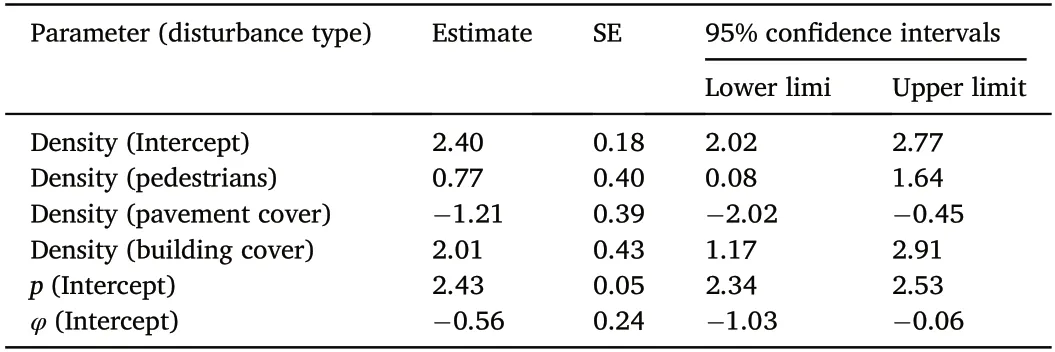
Table 2 Best-supported model's regression coefficients,standard errors(SE),and 95%confidence intervals for relationships between disturbance types and the density of the White-winged Dove during winter.Best-supported model is represented by:density{pedestrians+pavement cover+building cover}p{.}φ{.};p:detection probability;φ:availability for detection.

Table 3 Estimated means of the perching probabilities at each type of urban area(a–b)and estimated means of the posterior distribution of differences between two types of urban areas in the perching probabilities of the White-winged Dove(c).SD:standard deviation;HDI low:lower limit of 95% highest posterior density interval;HDI up:upper limit of 95% highest posterior density interval;**:significant differences between pairs of land uses.
4.Discussion
Although agricultural fields represent an important habitat for the White-winged Dove(Waggerman and Sorola,1977;West,1993),we were not able to detect the species within cropfields.Some of the cropfields that we surveyed might not be adequate enough for the species(e.g.,tomato,potato),given that they do not produce grains on which the species feeds(Cottam and Trefethen,1968;Dolton,1975;Cunningham et al.,1997).Corn was actually included among studied crops(30% of the fields),but it was already harvested or the plant did not present grains ready for consumption.As a result,during this particular time of the year,cropfields might not offer critical feeding resources for the White-winged Dove,forcing the species to find food in other land uses for surviving winter.Moreover,natural habitats are not present within or close to cropfields,which might limit the availability of natural food and roosting sites for the dove(Bautch,2004),and ultimately deterring its presence from local agricultural land uses.
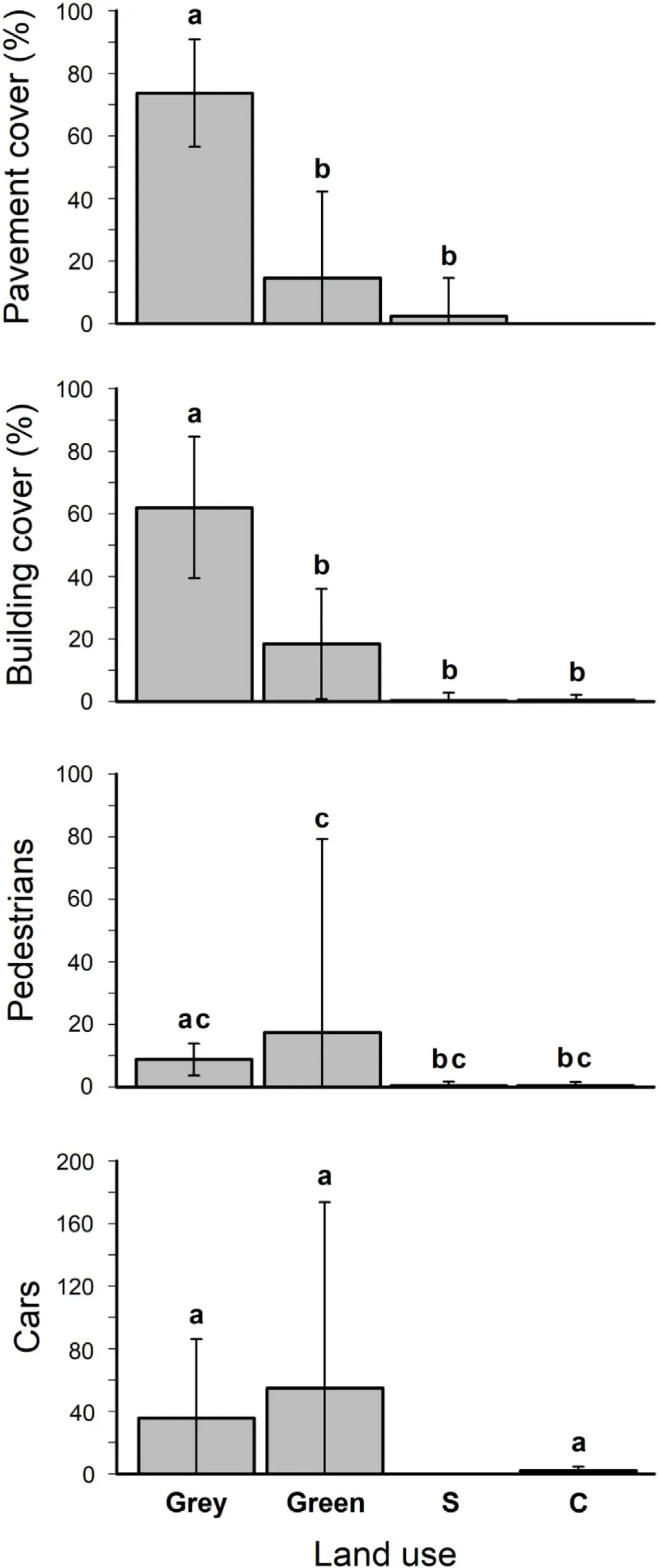
Fig.2.Variation of disturbance types between urban grey areas,urban green areas,shrublands(S),and cropfields(C)in Los Mochis,Sinaloa.Letters above columns depict significant differences among land uses.
In contrast to surveyed cropfields,the urban area served as an adequate habitat for the White-winged Dove(West,1993;Small et al.,2006;Schwertner et al.,2020).In fact,the records of the species heavily concentrated within the city(98% of the observations).Still,a specific disturbance type might limit the density of the dove:pavement cover.Increasing pavement cover might result detrimental for the White-winged Dove given that such disturbance might reduce the area of the preferred foraging substrates of the species,as this dove usually searches for seeds in ground litter and for fruits on large shrubs(e.g.,cacti)(Dolton,1975;Brown,1989;Cunningham et al.,1997;Wolf and del Rio,2000).Urban grey areas might be more unfavorable for the density of the species than urban green areas as the former showed the highest pavement cover among land uses.Hence,urban green areas might prove important for the White-winged Dove given that pavement cover is reduced within these sites,which might provide better ground foraging conditions for the species(De Graaf et al.,1985).
Pedestrians and building cover were positively associated with the density of the White-winged Dove.On the one hand,an increment of pedestrians number might have a positive effect on the species because people in the city directly feeds the species with scraps of bread and tortilla,and indirectly provides food for the dove through leftovers.Additionally,we have seen the White-winged Dove feeding around the thrash cans found in public places,which reinforces previous observations of the species using anthropogenic food in urban settings(Small et al.,2006).On the other hand,building cover might result beneficial for the species as it provides shelter and perching opportunities for urban birds(Macgregor-Fors and Schondube,2011;MacGregor-Fors et al.,2012),which result vital to cope with urban threats.
We observed that surveillance behavior peaked in urban grey areas.Different threats might increase surveillance behavior of the dove within this land use.In particular,potential collisions with urban infrastructures(e.g.,windows)(Hager et al.,2017);predatory pressures by dogs and cats(Loss et al.,2013);and agonistic interactions with invasive species(e.g.,Great-tailed Grackle Quiscalus mexicanus,Rock Pigeon Columba livia,Eurasian Collared-Dove Streptopelia decaocto)(Bonter et al.,2010;Schwertner et al.,2020)might intensify the need of the dove to be in constant vigilance within urban grey areas.A different pattern was recorded for urban green areas,where the White-winged Dove surveiled the least.As opposed to urban grey areas,greater vegetation levels of urban green areas might increase the opportunities for the White-winged Dove to take cover from urban threats(Idilfitri and Mohamad,2012;Ikin et al.,2013;Threlfall et al.,2017),reducing risk perception and ameliorating the need to perch and surveil surroundings(Campos et al.,2009).In sum,urban green areas might be perceived as safer habitats by the White-winged Dove than urban grey areas.
5.Conclusions
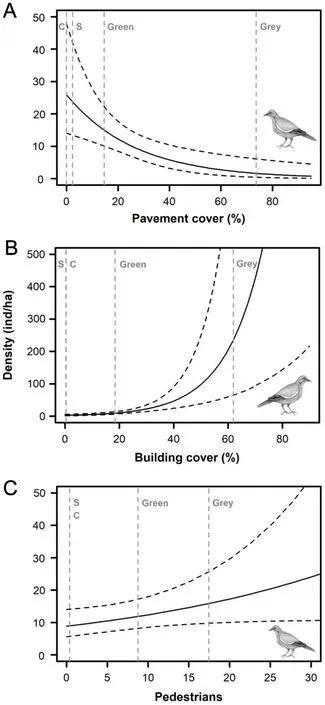
Fig.3.Relationship between(A)pavement cover,(B)building cover,(C)pedestrians and the density(individuals per hectare)of the White-winged Dove during winter.Black dashed lines depict 95% confidence intervals of density estimations.Grey dashed lines show mean values of disturbance types for each land use.Grey=urban grey areas;Green=urban green areas;S=shrublands;C=cropfields.
During this time of the year,cropfields might not be important for the White-winged Dove because feeding resources might be scarce.Even natural ecosystems were not very attractive for the species,as we had only a few records of the species within shrublands.However,we demonstrated that urban areas were key for the dove,which acted as an urban exploiter species during winter at our study site(McKinney,2006).We observed that not all human disturbances were detrimental for thespecies,as pedestrians and building cover promoted the increment of the density of the White-winged Dove.Still,reducing pavement cover,particularly within urban grey areas,might increase the density of the species across the landscape,as such disturbance type negatively affected the dove.Our behavioral analysis revealed that surveillance varied among land uses,peaking at urban grey areas.Although both urban grey and urban green areas provide adequate habitat conditions for the White-winged Dove,greater risk might be perceived by the species in urban grey areas than within urban green areas.Through a simultaneous demographic and behavioral study,we were able to assess a comprehensive analysis of bird responses to human disturbances on a landscape heavily impacted by urbanization and agriculture.Our approach might be replicated for different species and regions of the globe.Further studies are required to understand the variation of the observed patterns among seasons at the study site.
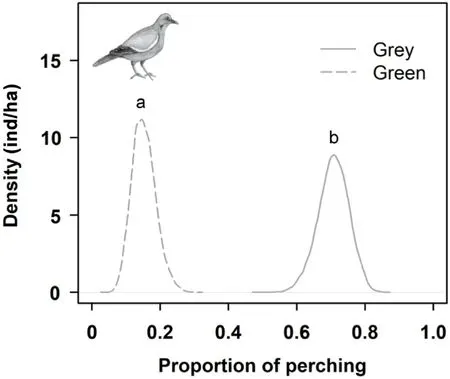
Fig.4.Distributions of the estimated perching proportions of the White-winged Dove in urban grey areas(Grey)and urban green areas(Green)during winter.Letters above curves depict differences among land uses.
Ethics statement
Ethical review and approval was not required for the study because we did not manipulate animals.Our research was not experimental,but observational.
Funding
Financial support was provided by CONACYT,through the project“Importancia del JB Benjamin Francis Johnston y otras′areas verdes urbanas para las aves en los Mochis,Sinaloa,durante la′epoca migratoria y reproductiva del 2021”(Fondo FORDECYT-PRONACES).
Authors’contribution
All authors conceived and designed the study;JL-A collected the data;RO-A analyzed the data;the first draft of the manuscript was written by RO-A and all authors commented on previous versions of the manuscript.All authors read and approved the final version of the manuscript.
Declaration of competing interest
The authors declare that they have no known competing financial interests or personal relationships that could have appeared to influence the work reported in this paper.
Acknowledgements
We are grateful to the Jardín Bot′anico Benjamin Francis Johnston for the logistical and financial support provided for the development of this study,which is associated to the project“Importancia del JB Benjamin Francis Johnston y otras′areas verdes urbanas para las aves en los Mochis,Sinaloa,durante la′epoca migratoria y reproductiva del 2021”(Fondo FORDECYT-PRONACES,CONACYT).We acknowledge the Programa de Aves Urbanas(PAU)of CONABIO,specially Tatiana S′anchez Rodríguez,for promoting birdwatching in Los Mochis.RO-A received the support from the DGAPA-UNAM Postdoctoral Fellowship 2021–2022 during which this article was completed.We thank two anonymous reviewers who provided valuable suggestions that improved the quality of our work.
杂志排行
Avian Research的其它文章
- Comparative population genomics reveals glacial cycles to drive diversifications in tropical montane birds(Aves,Timaliidae)
- Identification of annual routines and critical stopover sites of a breeding shorebird in the Yellow Sea,China
- Differing migration patterns and year-round habitat-use of allopatric nesting Eastern Tundra Bean Geese(Anser fabalis serrirostris)in East Asia
- GPS tracking data reveal the annual spatiotemporal movement patterns of Bridled Terns
- Ecological traits affect the seasonal migration patterns of breeding birds along a subtropical altitudinal gradient
- Urban avifauna distribution explained by road noise in an Eastern European city
